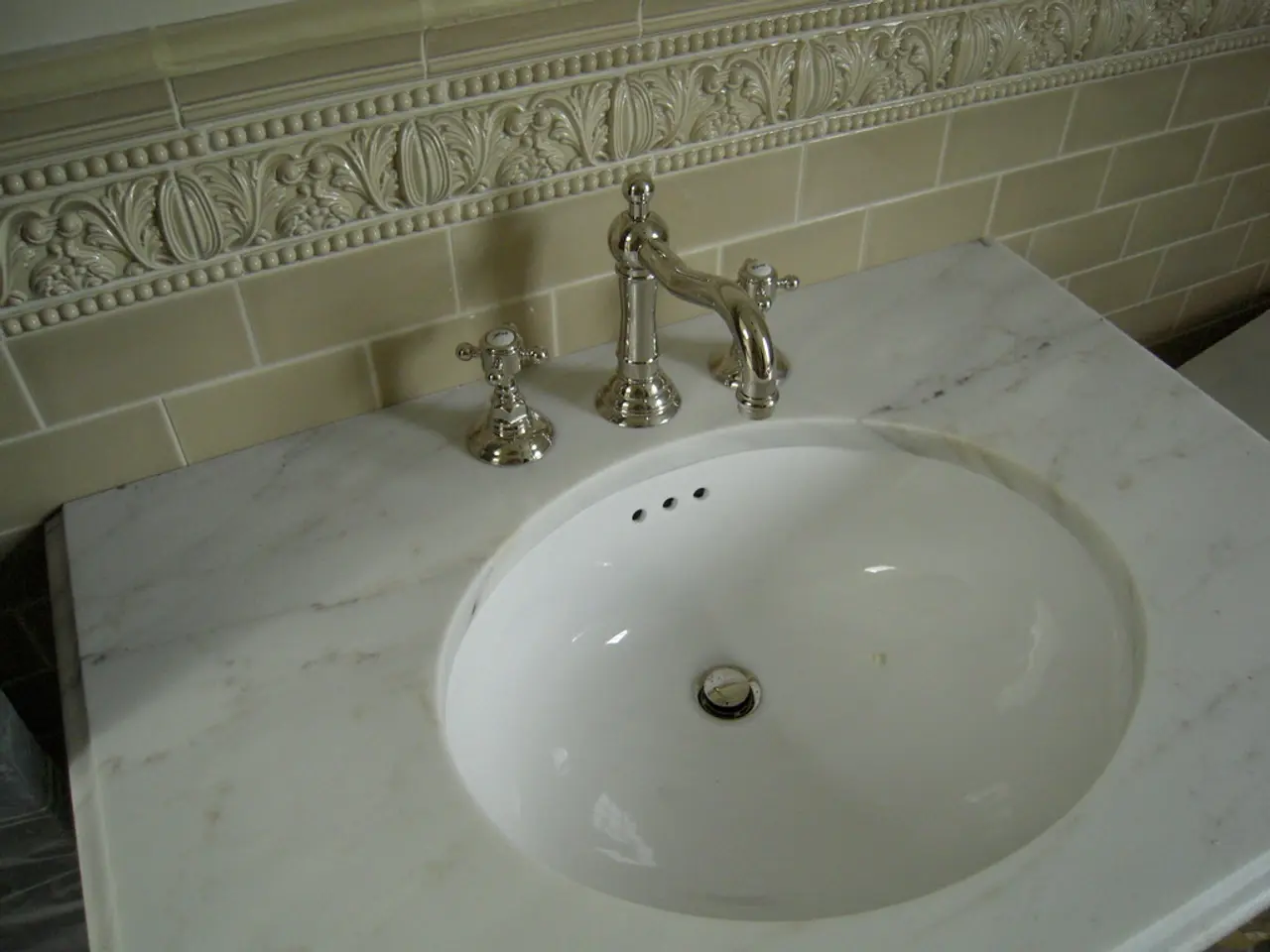Exploring the concept of bookmatching: Does this aesthetically pleasing kitchen veneer upgrade add an element of sophistication to your kitchen design?
Bookmatching is a captivating design technique that has found its way into modern kitchens, adding an air of luxury and architectural interest. This finishing touch creates a symmetrical, open-book-like pattern, enhancing the natural veining or grain of materials such as marble, stone, or quartz[1][3].
Effective Use of Bookmatching in Different Kitchen Areas
Bookmatching can be employed on various surfaces within a kitchen, transforming countertops, islands, backsplashes, and even cabinet panels into striking focal points.
- Countertops and Islands: By running bookmatching across horizontal surfaces, such as countertops and kitchen islands, designers create a visual drama with flowing veining or wood grain, making the island a centrepiece[2].
- Backsplashes and Walls: Bookmatching can be extended vertically onto backsplash walls or range hoods, creating a continuous, cohesive look that unifies different kitchen planes[2]. Off-centre mirror axes can add a more organic and dynamic flow[2].
- Waterfall Edges: Combining bookmatching with vein matching on waterfall edges ensures a perfect alignment of veins or grain, maintaining design continuity and luxury appeal[1].
- Cabinet Panels: When using wood veneer, bookmatching adjacent panels creates a visually stunning centrepiece that highlights natural grain symmetry, especially on cabinet doors or furniture elements within the kitchen[3].
Suitable Materials for Bookmatching
Natural stones with distinctive veining, like Calacatta marble, are particularly suited to bookmatching due to their bold and singular vein patterns that translate beautifully into symmetrical designs[1][4]. Other natural stones with consistent vein patterns can also be cut and matched, but the availability of enough slabs and careful manufacturing is essential to maintain the pattern and color harmony[1].
Bookmatching is also highly effective with wood veneers, where matching the grain on adjacent panels produces dramatic, central visual effects[3].
Key Considerations
Achieving bookmatching requires specifically manufactured slabs cut sequentially and in sufficient quantity to maintain consistency. Reducing slab count compromises the effect[1]. Carefully plan seam locations to ensure the mirror effect is visible and enhances focal areas in the kitchen, such as islands or main walls[2].
For waterfall edges and mitred joints, combining bookmatching with vein matching ensures a natural flow of veins or grain, enhancing luxury and attention to detail[1].
Experts in the field, such as Oli Webb, Director at Cullifords with over 20 years of experience in the stone industry, and Matthew Weatherill, Head of UK Installations at Wren Contracts with over five years of experience in the kitchen, bedroom, and bathroom sectors, have been instrumental in driving the growth of bookmatching in modern kitchen designs[2][3][4].
In summary, bookmatching can elevate the look and feel of any kitchen space, creating a dramatic and impactful statement. By selecting materials that lend themselves to creating striking symmetrical patterns, such as bold-veined natural stones like Calacatta marble or high-quality wood veneers, designers can amplify the luxury and cohesion of kitchen spaces. Proper slab selection, seam positioning, and integration with vein matching ensure a low maintenance yet high-quality decorative touch.
- The captivating design technique of bookmatching is not limited to modern kitchens; it can also be extended to other areas of the home, such as the bathroom, living room, or home-and-garden.
- In a bathroom setting, bookmatching can be applied to windows, vanity tops, or even the tiles around a bathtub, adding elegance and symmetry to the room's design.
- On a loft conversion, bookmatching could be employed on sloped roof surfaces, creating a unique and stylish effect that complements the open and airy lifestyle of a loft space.
- When working within a budget, designers can still incorporate bookmatching ideas by choosing cost-effective materials like affordable engineered stones or budget-friendly wooden veneers that maintain the desired design aesthetic.
- In a more traditional home, bookmatching can be used as a nod to classic architecture, with doors and door frames receiving the symmetrical treatment to emphasize the home's historical character.
- The growing popularity of open-plan living has seen bookmatching extend beyond the kitchen, with designers using the technique on walls that link the kitchen, dining, and living areas, creating a unified and luxurious atmosphere.
- Whether you're undertaking a kitchen renovation, building a new home, or simply looking to update your current interior, incorporating bookmatching and its design principles is a guaranteed way to add a touch of sophistication and architectural interest to your lifestyle.




